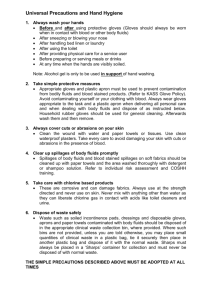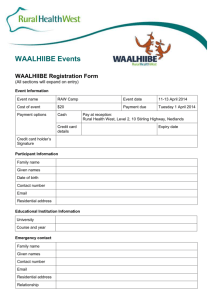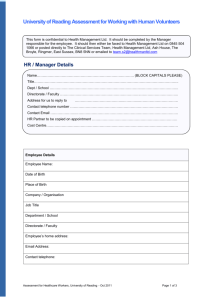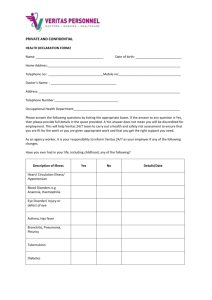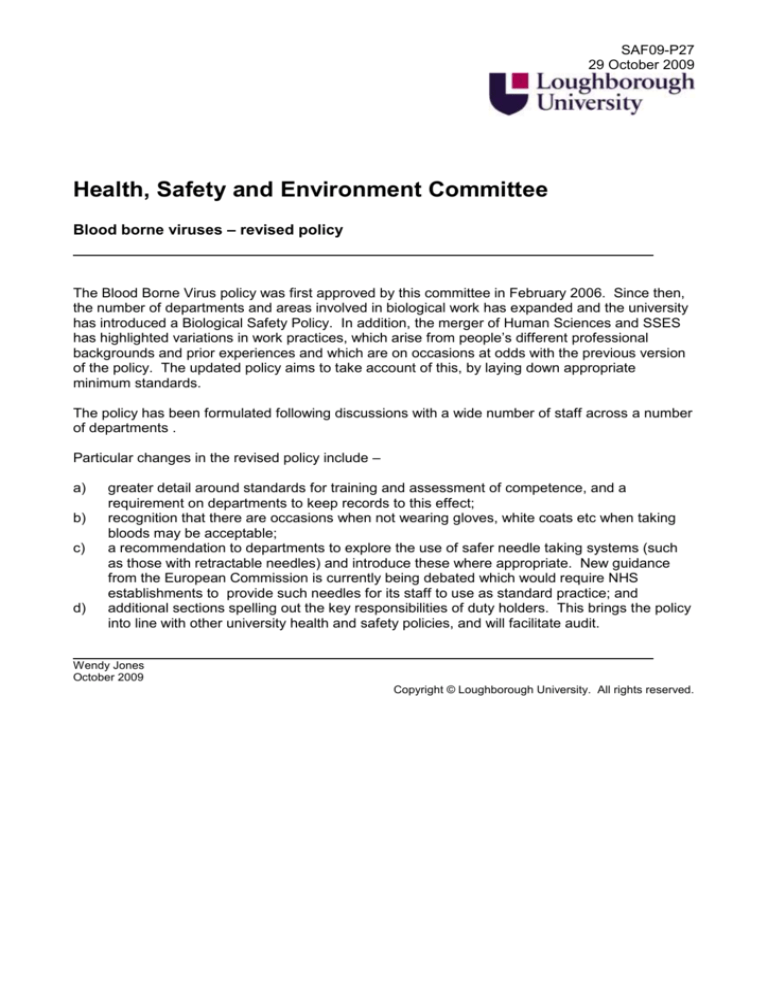
SAF09-P27
29 October 2009
Health, Safety and Environment Committee
Blood borne viruses – revised policy
The Blood Borne Virus policy was first approved by this committee in February 2006. Since then,
the number of departments and areas involved in biological work has expanded and the university
has introduced a Biological Safety Policy. In addition, the merger of Human Sciences and SSES
has highlighted variations in work practices, which arise from people’s different professional
backgrounds and prior experiences and which are on occasions at odds with the previous version
of the policy. The updated policy aims to take account of this, by laying down appropriate
minimum standards.
The policy has been formulated following discussions with a wide number of staff across a number
of departments .
Particular changes in the revised policy include –
a)
b)
c)
d)
greater detail around standards for training and assessment of competence, and a
requirement on departments to keep records to this effect;
recognition that there are occasions when not wearing gloves, white coats etc when taking
bloods may be acceptable;
a recommendation to departments to explore the use of safer needle taking systems (such
as those with retractable needles) and introduce these where appropriate. New guidance
from the European Commission is currently being debated which would require NHS
establishments to provide such needles for its staff to use as standard practice; and
additional sections spelling out the key responsibilities of duty holders. This brings the policy
into line with other university health and safety policies, and will facilitate audit.
Wendy Jones
October 2009
Copyright © Loughborough University. All rights reserved.
Health and Safety and Environment Committee
Blood borne viruses
CONTENTS
1.
University Policy
1.1 Policy Statement
1.2 Scope
2.
Procedures / Guidance.
2.1
2.2
2.3
2.4
2.5
2.6
2.7
2.8
General principles
Cleaning and disinfection
Gloves and skin protection
Waste disposal and sharps
Immunisation
Needlestick injury
Training
Fitness for work
3.
Definitions.
4.
Further Reading.
APPENDICES
A
Good handwashing technique
B
Recommended procedure in case of needlestick injury or other exposure to
blood/blood stained fluids
C
Venepuncture – minimum standards
Health, Safety & Environment Office
Revision for H&S ctte, nov 09
This document forms part of the University Health & Safety Policy.
1.
POLICY
1.1 Policy Statement
It is the policy of Loughborough University to prevent or control the risk of exposure to blood borne
viruses, the main viruses of concern being human immunodeficiency virus (HIV, which causes
AIDS), hepatitis B and hepatitis C.
The main legislation which is relevant to this subject is the Control of Substances Hazardous to
Health (COSHH) Regulations 2002, which includes a specific requirement to manage biological
hazards (see Loughborough University’s Control of Substances Hazardous to Health Policy .
Unscreened blood is a biological hazard in Hazard Group 2. All planned work which involves this
must also comply with the University Biological Safety Policy.
1.1 Scope
This policy covers anyone across campus who is at risk of exposure to Blood Borne Viruses
(BBV). These viruses are carried in the blood of infected people (who may not know they are
infected). They are also carried in other body fluids such as semen, vaginal secretions and breast
milk.
Body fluids such as saliva and urine may contain the virus but are unlikely to carry an infection risk
unless they contain visible blood.
Those covered by this policy include, but may not be limited to:a)
Staff carrying out research which involves taking blood or working with blood in a laboratory
b)
Students (under supervision of staff)
c)
University staff working in the medical centre
d)
Staff providing beauty therapies at Burleigh Court
e)
Facilities Management (including Security) and imago staff who may be exposed to
contaminated sharps in the course of their work
f)
First aiders
g)
Those providing personal care for disabled students
All departments and sections which have identified a potential for exposure to BBVs must carry out
local risk assessments of appropriate activities, taking into account the general guidance given in
this policy.
2.
PROCEDURES / GUIDANCE
2.1 General principles
The risk of exposure to blood borne viruses can be significantly reduced by following the guidance
in this policy, and by:a)
Good hand washing practices.
b)
Protective clothing, proportionate to the level of risk.
Health, Safety & Environment Office
Revision for H&S ctte, nov 09
This document forms part of the University Health & Safety Policy.
c)
Covering broken skin with plasters.
No food or drink shall be consumed in any area where there may be a risk of exposure to BBVs.
A possible exception to this is where venepuncture is being performed as part of research
activities and research subjects are provided with food and drink as part of the research protocol.
2.2
Cleaning and Disinfection
Spillages of blood or other body fluids should be cleaned up using suitable disinfectants, such as
1% Virkon solution or equivalent and disposable paper towels or cloths (see waste disposal
guidance below). Local COSHH assessments must be in place covering the use of such
substances.
Reusable equipment which is visibly contaminated should be washed in warm (not hot or cold)
soapy water prior to disinfection according to local policy.
Laboratory clothing should be washed at a high temperature, ideally at least 60C. For clothing
accidentally contaminated with blood which cannot be washed at these temperatures bleach
should be included in the washing process
2.3 Gloves and skin protection
Disposable gloves must be worn when handling body fluids or materials which may have been
contaminated with body fluids, or when there is a potential for exposure e.g. during first aid.
Gloves must be of a type suitable for the activity, further guidance on this is available from
http://www.hse.gov.uk/latex/labs.htm
The only exception to this is where an experienced operator chooses not to wear gloves during
venepuncture, see Appendix C.
Powdered latex (rubber) gloves must NOT be used because of the high risk of causing allergic
reactions.
If latex gloves are used they must be powder free and have a low level of extractable proteins (
less than 50 mcg/g). Users must be made aware of the potential for developing allergy and
measures should be in place for identifying others (e.g. clients, research subjects, students), who
have a pre-existing allergy.
Nitrile gloves are often a good alternative to latex .
Glove wearing does not replace the need for handwashing – hands must be washed after wearing
gloves. See Appendix A for guidance on good handwashing techniques.
Alcohol-based hand rubs (minimum alcohol content 60%) may be used as an alternative to
handwashing when hands are not visibly contaminated e.g., between research subjects and after
removing gloves.
2.4 Waste Disposal and sharps
All sharps must be placed in a designated plastic puncture-proof sharps container for disposal by
incineration. Local arrangements shall be established to ensure proper disposal of used sharps
containers.
Syringe packaging should not be placed in sharps boxes.
Health, Safety & Environment Office
Revision for H&S ctte, nov 09
This document forms part of the University Health & Safety Policy.
All contaminated material, e.g. cloths, swabs and paper towels containing blood and other body
fluids, should be put into plastic yellow bags, preferably in lidded bins. If use of lidded bins creates
a risk of contamination small open bins may be used provided the contents are transferred to a
larger bin on a frequent basis (e.g. every hour or two).
After double bagging and sealing these large bags must be disposed of by incineration. Local
arrangements shall be established to ensure proper disposal.
Blood stained waste generated by first aid incidents must be disposed of properly. For
departments which have a system of clinical waste disposal already in place, this can be used. In
other departments, it is acceptable for such waste to be disposed of via sanitary bins.
2.5 Immunisation
Immunisation against hepatitis B is recommended for those who may be exposed to human
blood/blood stained body fluids in the course of their work where risk assessment indicates that
this is necessary. It can be arranged through the Occupational Health department. If
immunisation is required for work involving NHS patients or work in an NHS hospital a research
passport may also be required.
Departments where there is a known risk of exposure to blood should encourage staff to advise
the department of their immune status regarding hepatitis B.
Routine vaccination against hepatitis B is not normally considered necessary by the Health and
Safety Executive (HSE) for first aiders. Protection with gloves, resuscitation devices etc will
greatly reduce risk. There are no instances recorded of HIV or hepatitis B being passed through
mouth to mouth resuscitation.
There is no immunisation available to protect against hepatitis C and HIV. Therefore, good
practice as outlined in this policy is of paramount importance at all times.
2.6 Needlestick injury
In the event of a needlestick injury (e.g. penetration of the skin with a used needle) or any other
possible exposure to BBVs (e.g. through blood splash to the eyes, mucous membranes or broken
skin), the injury site should be washed under running water and (where appropriate) gently
encouraged to bleed.
Advice may be sought from Occupational Health (ext 222851), alternatively the injured party
should contact their GP or visit the walk in centre (01509 553998) as soon as possible. The
following processes will usually be required:a)
Blood to be taken from the injured party for storage only (i.e. to be tested if infection is later
found to have occurred)
b)
Blood to be taken from the ‘source’ if known – i.e. the person on whom the needle was used
prior to the injury. This will require a competent person, (e.g. Occupational Health, the
source patient’s GP), to advise the patient on the implications of testing, and to seek consent
to test for hepatitis B, hepatitis C and HIV.
c)
Blood to be taken from the injured party 3 and/or 6 months after the incident to ensure no
infection has occurred. This is particularly important if the ‘source’ patient is not known e.g. if
the incident is caused by a needle of unknown origin.
Further details, and guidance for GPs and/or the walk in centre on University policy can be found
at Appendix B.
Health, Safety & Environment Office
Revision for H&S ctte, nov 09
This document forms part of the University Health & Safety Policy.
Any injury of this nature must be reported to the Health and Safety department on the University
Accident Report Form Additionally, the incident could be reportable under the Reporting of
Injuries, Diseases and Dangerous Occurrences Regulations (RIDDOR) 1995.
2.7 Training
All those who may be exposed to BBVs in the course of their work must receive appropriate
training in the measures required to minimise risk, and the steps to be taken in the event of a
needlestick injury.
This is in addition to any required training to ensure competence in particular techniques such as
venepuncture (see Appendix C)
2.8 Fitness for work
All staff and students working with unscreened blood for the first time must be referred to
Occupational Health for assessment of fitness for work, in accordance with the University
Biological Safety policy.
3.
Responsibilities of Duty Holders
3.1 Heads of Department must make arrangements to ensure that;a)
b)
c)
d)
e)
f)
suitable and sufficient risk assessments are in place (before work commences);
staff in the department/section have received suitable training;
the names of individuals commencing work with blood (which is a Hazard Group 2
biological hazard) are notified to the Occupational Health Adviser;
records are kept regarding the hepatitis B immunisation status of those who work with
blood;
where venepuncture takes place, records are kept to show which staff /postgraduate
students are approved to undertake venepuncture;and,
where venepuncture takes place, arrangements are in place to comply with University
guidance (Appendix C of this policy).
3.2 Managers/supervisors/leaders of research groups shall;a)
b)
c)
d)
e)
f)
carry out suitable and sufficient risk assessments;
ensure all staff/students have received appropriate training in relation to this policy and
BBVs in general; and in relation to venepuncture skills where required;
where venepuncture takes place, ensure arrangements are in place to comply with
University guidance (Appendix C of this policy);
ensure accidents resulting in potential exposure of individuals to BBVs are reported
promptly to Occupational Health (or the Health, Safety and Environment office) and
actions taken as in Appendix B of this policy;
ensure staff commencing work with unscreened blood are notified to the Occupational
Health Adviser, and,
monitor compliance with this policy.
3.3 Individuals shall
a)
b)
c)
d)
work in accordance with this policy;
report any difficulties complying with this policy;
report accidents resulting in potential exposure to BBVs to the manager/supervisor and
to Occupational Health, and follow the guidance in Appendix B, and,
if commencing work with blood, contact Occupational Health for advice on fitness for
this type of work and guidance on hepatitis B immunisation.
Health, Safety & Environment Office
Revision for H&S ctte, nov 09
This document forms part of the University Health & Safety Policy.
3.4 Occupational Health shall
a)
b)
c)
d)
e)
provide guidance to managers on the implementation of this policy;
provide/support training on request in accordance with this policy;
assess the fitness of individuals to undertake work with unscreened blood;
arrange hepatitis B immunisation where indicated, and maintain records; and,
issue certificates of hepatitis B immunisation where appropriate.
3.5 Imago shall
a)
b)
c)
4.
make arrangements for disposal of clinical, non-sharps waste arising from students
resident in halls;
ensure students are reminded of their personal responsibility to dispose safely of used
sharps, in liaison with their own GP and the local authority;
ensure staff have received suitable training e.g. in relation to what actions to take in
the event of needlestick injury, or on finding used sharps.
Definitions and explanations
Needlestick injury
Needlestick injury or percutanous exposure to BBVs, occur where the skin is cut or penetrated by
a needle or other sharp object (including teeth), which is or may be contaminated with blood or
body fluids.
Mucocutaneous exposure occurs when the eye, inside of the mouth or nose, or non-intact skin are
contaminated by blood or blood stained fluids. Blood splashing onto intact skin does not carry a
risk of exposure to BBVs.
Injured party
An individual who has suffered a needlestick injury or other exposure to blood or blood stained
body fluids.
Source patient
A person on whom a needle was intentionally used prior to needlestick injury of the injured party;
or the person whose blood has, for example, splashed an injured party in the eye. There may be
occasions where the source patient is unknown (e.g. if a needlestick injury is caused by a needle
discarded in waste)
Hepatitis B
Hepatitis B is found in the blood and body fluids of those who have or carry hepatitis B. It is most
commonly spread by unprotected intercourse, drug users sharing equipment and from mother to
baby at birth.
The prevalence of hepatitis B in the UK is 0.3 % (i.e. 3 cases per 1000 people), but is far higher in
some countries. Not all carriers of the disease are aware that they are infected.
Following a needlestick injury from an infected person to an unimmunised person, the risk of
hepatitis B transmission is about 1 in 3. The risk is much lower in mucocutaneous exposure.
Hepatitis B immunisation - A full course of hepatitis B vaccine consists of 3 injections at intervals
of 0,1 and 6 months. A single booster is required if at continued risk after 5 years. Where urgent
protection is required due to an activity which carries a high risk , hepatitis B immunisation can be
carried out to an accelerated schedule, at 0,1 and 2 months, with an additional dose at 12 months.
It is not anticipated that this will generally be warranted within the University.
Health, Safety & Environment Office
Revision for H&S ctte, nov 09
This document forms part of the University Health & Safety Policy.
If hepatitis B immunisation cannot be obtained through the GP, Occupational Health will make
arrangements for it to be carried out. Any costs incurred will be recharged to the individual’s
department.
The vaccine is effective in around 90% of people, a blood test is required 2 months after the third
dose of vaccine to ensure good immunity has been achieved.
If an individual who is not immune to hepatitis B is exposed to risk (see section 2.6, “Needlestick
injury”), an accelerated course of immunisation started at that time, (ideally within 72 hours), will
provide good protection. (see guidance for GPs under Appendix B)
Hepatitis C
Hepatitis C is most commonly spread by blood to blood contact, (e.g. sharing needles). It has a
prevalence in the UK of around 0.4 %; around 5 out of 6 people who have or carry it, are not
aware.
Following a needlestick injury from an infected person, the risk of hepatitis C transmission is about
1 in 30.
There is no immunisation against hepatitis C.
Human Immunodeficiency Virus (HIV)
Transmission of HIV is through similar routes to hepatitis B. Following a needlestick injury from an
infected person the rate of infection is around 1 in 300. If the exposure is mucocutaneous, (e.g.
blood splash to the eyes or broken skin), the risk drops to around 1 in 2000.
There is no immunisation against HIV.
4.
FURTHER READING
Immunisation against infectious diseases (the Green Book); HMSO, 1996
(available on-line from Department of Health)
http://www.dh.gov.uk/PolicyAndGuidance/HealthAndSocialCareTopics/GreenBook/GreenBookGen
eralInformation/GreenBookGeneralArticle/fs/en?CONTENT_ID=4097254&chk=isTfGX
Infection at Work – controlling the risks
Advisory Committee on Dangerous Pathogens
HMSO, 2003
(available on-line from Department of Health)
http://www.dh.gov.uk/PublicationsAndStatistics/Publications/PublicationsPolicyAndGuidance/Publi
cationsPolicyAndGuidanceArticle/fs/en?CONTENT_ID=4070102&chk=yQc0DS
Blood borne viruses in the workplace: Guidance for employers and employees
HSE 2004 (INDG342)
(available on-line from HSE)
http://www.hse.gov.uk/pubns/indg342.pdf
Guidance for Clinical Health Care workers: Protection against infection with Blood borne viruses
DOH 1998
(available on-line from Department of Health)
http://www.dh.gov.uk/PublicationsAndStatistics/Publications/PublicationsPolicyAndGuidance/Publi
cationsPolicyAndGuidanceArticle/fs/en?CONTENT_ID=4002766&chk=sjOK8W
Health, Safety & Environment Office
Revision for H&S ctte, nov 09
This document forms part of the University Health & Safety Policy.
NHS Skills for Health, Workforce competences; Obtaining Venous blood samples
http://www.skillsforhealth.org.uk/~/media/Resource-Library/PDF/Prevention%20First_v3.ashx PDF
pages 20 - 26
Health, Safety & Environment Office
Revision for H&S ctte, nov 09
This document forms part of the University Health & Safety Policy.
Appendix A
Good Handwashing techniques
Wash your hands:
before you eat, drink, take medicine, smoke, put on make up etc;
after any work activity where you may have become contaminated;
after removing gloves;
use soap and running water (preferably warm water as hot water increases the risk of skin
irritation);
wash all surfaces thoroughly including wrists, palms, back of hands and thumbs and under
fingernails;
rub hands together for at least 10 – 15 seconds, and,
rinse and dry hands well (on paper towels, or hand dryers – not on clothes!)
The wearing of watches, bracelets and rings will impair the effectiveness of hand washing. They
should be avoided as far as possible, where good hygiene is important.
Health, Safety & Environment Office
Revision for H&S ctte, nov 09
This document forms part of the University Health & Safety Policy.
Appendix B
If a needlestick injury occurs, a copy of this procedure should be taken by the injured party, (and
the source patient if known), to either their GP or the walk-in centre.
Recommended procedure in case of needlestick injury or other exposure to blood/blood
stained fluids
1.
Blood to be taken from injured party for storage
Details
Reason
2.
5-10 mls, clotted sample, to be labelled “needlestick injury – for storage”
If the injured party is later found to be infected with a BBV, the blood can be tested
to find out whether the infection was present prior to needlestick injury
Blood to be taken from source patient
Details
Blood to be tested for hepatitis B, hepatitis C and HIV
Informed consent will be needed for this; this should entail discussing with the
individual:Nature of HIV/Hep B/Hep C infection
Risk activities for infections
Benefits and implications to individuals of having a test/ testing positive
Details of test and how results will be provided.
Further information on HIV testing can be found at
http://www.bhiva.org/files/file1031097.pdf
Further information on hepatitis C can be found at
http://www.dh.gov.uk/assetRoot/04/03/28/46/04032846.pdf
Health, Safety & Environment Office
Revision for H&S ctte, nov 09
This document forms part of the University Health & Safety Policy.
3.
Review of injured party hepatitis B status
If the source patient is unknown, or is known to be Hepatitis B positive, hepatitis B vaccines should
be given in accordance with DoH guidelines
Details
If unimmunised – give accelerated course of hepatitis B vaccine
If unimmunised and source patient known to be HBV+ give HBIG in addition to
vaccine
If immunised, consider booster dose of hepatitis B
Further information on this can be found in the DoH Green Book (“Immunisation
against infectious Diseases”), also at
http://www.dh.gov.uk/PolicyAndGuidance/HealthAndSocialCareTopics/GreenBook/f
s/en
4.
Follow up blood tests for injured party
Details
If source patient is unknown, or if source patient is known to be positive for BBV,
test injured party blood at 3 and/or 6 months post incident.
Further information is available in Guidance for Clinical Health Care Workers:
Protection against infection with blood-borne Viruses, 1998, available at
http://www.dh.gov.uk/assetRoot/04/01/44/74/04014474.pdf
Occupational Health at Loughborough University is available on 01509 222851
Health and Safety at Loughborough University is available on 01509 222181
Health, Safety & Environment Office
Revision for H&S ctte, nov 09
This document forms part of the University Health & Safety Policy.
Appendix C
Venepuncture – minimum standards
a)
Protective clothing
Laboratory coats or side-fastening gowns and gloves will usually be worn, (and fastened!), at all
times when working in a laboratory environment, or during any activities where there is potential
for exposure to BBVs. Exceptions to this are that;–
Laboratory coats need not be worn during venepuncture or when taking blood by
fingerprick sample. However, where there is a high risk of blood splash, (e.g. during
cannulation), a plastic apron or white coat may be considered appropriate.
Experienced operators may choose not to wear gloves during venepuncture. However,
wearing gloves is strongly recommended – although gloves will not protect against
needlestick injury, they may reduce the likelihood of inoculation with blood, (or the volume
of inoculation), if a needlestick injury occurs.
Any clothing, gloves or laboratory coats which become contaminated with blood must be removed
as soon as possible.
In addition, protective eye wear should be worn during procedures that are likely to generate
splashes of any body fluids containing visible blood.
b)
Training
Venepuncture and cannulation and withdrawal of blood from a cannula, must only be carried out
by staff or postgraduate students who have been trained and assessed for competency. A list of
competent persons will be held in each department and reviewed annually.
Training for venepuncture and cannulation may be carried out by an external provider or in-house;
as a minimum it should include the following; –
Health and safety and infection control including
o good handwashing technique;
o use of gloves and other protective clothing;
o risks of blood borne viruses;
o hepatitis B immunisation;
o action in case of a needlestick injury.
Anatomy and physiology of the arm
Identifying the subject/participant
Getting informed consent
Contraindications to venepuncture
How to find and prepare a suitable site for Venepuncture
Correct Application and removal of Tourniquet
Labelling samples, which bottles are required for which test and the order of draw
Gaining venous access, using the appropriate venous collection system (e.g. monovette,
Sarstedt)
Mixing blood and anticoagulant where appropriate
Safe disposal of sharps
Control of bleeding
Possible adverse reactions (e.g. bleeding, fainting) and how to manage these (and report if
necessary)
Health, Safety & Environment Office
Revision for H&S ctte, nov 09
This document forms part of the University Health & Safety Policy.
Action to take if venepuncture is unsuccessful
Storage or transportation of blood samples
Personal responsibility for keeping learning up to date e.g. use of a personal log
Formal assessment of competence is required for all staff and postgraduate students newly
trained in venepuncture. This must include a minimum of 15 venepunctures supervised by a
member of University staff experienced in venepuncture or a qualified, experienced phlebotomist;
and formal ‘signing off’ by a different, experienced member of University staff or a medical doctor.
Additional training and supervision will be necessary if additional skills are required, e.g. if a
member of staff has been assessed competent with one blood taking system but then wishes to
use another; or if they have venepuncture experience but wish to undertake cannulation.
Fingerprick testing may be carried out by undergraduate students who have received suitable
training, including the risks of BBVs and how to protect themselves. There must be supervision by
a competent member of staff.
c)
Skin preparation
Provided skin is visibly clean, skin disinfection prior to venepuncture or fingerprick testing is not
usually required.
If a cannula is to be left in place, the skin may be cleaned with 70% isopropyl alcohol and allowed
to dry (30 seconds) before venepuncture.
d)
Exclusion of infected subjects
Where volunteer subjects are sought for research involving blood sampling, steps must be taken
to exclude those who know they carry a BBV or whose partner has a BBV. This can be achieved
discreetly by including advice to this effect on research information documents which are given to
potential subjects.
e)
Ethical approval
Where blood samples are taken for the purposes of research, this is subject to approval by the
University Ethics Committee, after a suitable application has been submitted
f)
Risk minimisation
Steps must be taken to minimise the risks to staff/students arising as a result of venepuncture.
Particular attention should be given to the following; –
a) closed systems should be the standard means of taking blood (e.g. Vacutainer, monovette,
Sarstedt);
b) techniques involving syringe and needle or syringe and butterfly involve an increased risk
of needlestick injury and should only be employed in exceptional circumstances;.
c) needles should not usually be removed from the syringe before disposal into sharps
boxes;.
d) needles must never be resheathed and,
e) where possibly, intrinsically safe systems should be used, e.g. retractable needles. This is
of particular importance if open systems are being used (as at (b) above).
Health, Safety & Environment Office
Revision for H&S ctte, nov 09
This document forms part of the University Health & Safety Policy.



